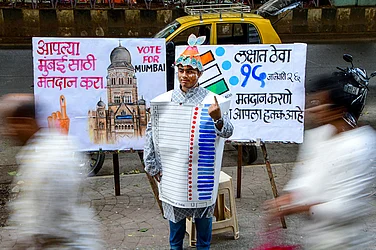A week after the death of a 17-year-old student of the Bengali Department at Jadavpur University (JU), the authorities decided to install CCTV cameras at ‘strategic’ points. The National Commission for Protection of Child Rights (NCPCR) sought an explanation from the varsity as to why there are no cameras on the hostel premises. Trinamool Congress (TMC) MP and advocate Kalyan Banerjee, who filed a petition on behalf of TMC spokesperson Sudeep Raha, in the Calcutta High Court asked why the university has no CCTV cameras. Meanwhile, a student from the university was vilified on a prime-time show for resisting the installation of the cameras and letting crimes happen inside the campus.
As the probe into the death of the student continues, a shrill chorus grows — JU needs CCTV surveillance for students’ safety, curbing ‘illegal activities’, and bringing in law and order. As one section of the students has come out in the media protesting the surveillance inside a space, largely known for harbouring free and liberal thinking, the other section believes that there is more to it.
‘Jadavpur is not against CCTV’
“Ragging stems from a psyche of domination and the fight against is larger. CCTV installation is a minuscule part of the solution and it does not stop the social issue of the ragging culture,” says Srijan, former JU student and the General Secretary of the Student Federation of India (SFI), West Bengal.
However, Srijan points out that a false narrative is being spun that students and teachers of JU are against CCTV. “JU is a residential campus, which already has a lot of CCTV cameras and no one has ever tried to meddle with them. Just because a handful of students are protesting does not mean everyone is part of that. There is this one small section that has said that we have the right to drink and smoke inside the campus and the entire narrative is being built that JU protests CCTV installations because we want this. It is not so.”
Students believe that the installations must be done across locations unanimously agreed upon by stakeholders that comprise students, teachers, non-teaching staff, and so on. This has been the most dominant opinion by all student organisations including the SFI. “If you look at the protests by TMC and BJP students’ unions, they have absolutely created a different narrative that JU has no CCTV cameras and people do whatever they want. Through this, they are also trying to gain their own political agenda, which has been their long-due demand. Our point is to discuss unanimously where can we regulate security more,” he says.
Sandip (name changed), a research scholar at the university, echoes a similar opinion when he points out that the assembly at their level has proposed a similar view to the varsity authorities, of understanding and deciding together which locations require regulated security. “To the narrative of ‘illegal activities’, we, students don’t want that either. Even the scholar’s assembly has urged the administration to come up with guidelines to not make it a ‘disorganised campus’. But again, the installation of CCTV cameras without much discussion and thought will lead to no fruitful situation,” he says. Several authoritative bodies have accused the University of violating the guidelines of the University Grants Commission (UGC) in terms of surveillance cameras at vital points. However, in 2015, UGC said that its guidelines are ‘suggestive’ and not ‘mandatory’.
The point of contention is that the guidelines say that few of these ‘points’ have to be hostels and corridors. “Of course, it’s true that with the cameras, maybe we could see and understand how the student died. But we cannot dismiss the fact that several students believe that hostels are where they stay. And cameras in corridors are an absolute intrusion into their privacy. If some discussions and deliberation are done around these, we can come up with an alternate way to work around them,” Srijan states.
Cameras are fine to catch petty thefts and identify perpetrators, but can they really put a stop to this entire ragging culture? “Take examples of premium colleges like IITs, and IIMs, do they not have the entire campuses under CCTV surveillance? Are there no such suicides and ragging happening there? It’s happening so rampantly. The answer is right there," Sandip notes.
Students cite the attack on Jamia Millia University’s main library, following anti-CAA protests in 2019. When Jamia’s library and Jawaharlal Nehru University were attacked, people covered their faces to protect their identity from the cameras. "They were the police. What help did surveillance do there? What punishment was ever meted out to them?” cry students and people associated with JU.
What is the efficacy of CCTV? Looking at data and question of privacy
In 2020, Surfshark in the data report showed that the crime intensity doesn’t actually decrease with the increase in CCTV cameras. New Delhi, Indore, Hyderabad and Chennai though have the highest numbers of CCTV cameras in the country, but their rank in the crime index remains higher than Kolkata, Bangalore or Kochi which have less intensity of surveillance cameras. And concerns on privacy and state-backed surveillance are mounting.
Prior to this, a Supreme Court-appointed panel in 2015 maintained that measures to check ragging in educational institutions should not be limited to CCTV cameras which are often illegal as they intrude upon privacy. The apex court cited a report —Psychosocial Study of Ragging in Selected Educational Institutions in India— submitted to the UGC that noted, “This sort of intervention does not address the root causes of ragging.”
CCTV cameras create an air where one always feels that they are being watched and surveilled.
Abdul Kafi, a professor of Bengali at JU, says, “They always try to justify that people are engaging in illegal activities here, but imagine those people who are here to enjoy the liberal space the University has to offer. Why must they suffer and be watched? By catching one abuser, you will be intruding into the privacy of ten others who are innocent." With many assertions, he believes that with the entire chorus of CCTVs, currently, no one is thinking clearly. They are thinking in haste because all of them are coming from a space of grief --- questioning the 'but(s) and what-ifs' to have been able to save a young life.
But, several questions continue --- in how many places/spots will you be able to install cameras? Is it possible to place inside rooms and washrooms? Or do they even want it there? So, if someone wants to rag, if someone derives that sadistic pleasure from bullying others, that person would do it in blind spots. So maybe with CCTV, they would not do it openly, they would do it privately. What stops it?
Ragging is a social phenomenon, not a CCTV issue
Despite India’s stringent ragging laws in place, several premium institutions in the country report cases of ragging that take away young lives. Although subsequent rules brought in a welcome change, holding the perpetrators accountable, legal experts and sociologists believe that it was never enough to prevent ragging from being a regular activity in many colleges.
In a previous interview with Outlook, Dr Ajay Saini, a professor at IIT Delhi said that the laws against ragging are not enough as there are other external factors that aid ragging incidents in colleges.
“We all come from an unequal society sheltered by unequal homes. The differences of who’s upper and lower, who’s powerful and weak, and what’s good and bad have been institutionalised for years. Ragging is the result of this — belonging to a layered society that has legitimised class, caste, gender, and sense of superiority,” says Disha Nawani, a professor of sociology at Tata Institute of Social Sciences.
Nawani states that the primitives of ragging and bullying trickle down to schools, where nothing is questioned and actions are justified. What adds to this is the societal background of a student and child, the values he has grown up with and what behaviour he has been made to feel just. “Cameras can do little to no help in addressing ragging. It’s a larger problem that must be seen as a social phenomenon,” she says.
In context to what happened to the student, who was allegedly harassed for his femininity, Kafi, asks those who are emphasising that ragging will happen, hence there must be cameras, why they are dismissing the flip question: “Why should there be ragging? Isn’t it more important to discuss measures in addressing and curbing it? But this question gives rise to more disturbing and hard-hitting questions — whoever would be nabbed guilty is not guilty alone!”
CCTV: A lack of accountability of an institutionalised issue
All the students, who have been identified as alleged perpetrators, come from middle-class families and many of them have to have battled poverty. “It’s not true that their blood is infested with the virus of a criminal mind. We as a society have made them the criminals, we are trying to portray them as,” Kafi says.
A visibly troubled Kafi blames the society, as a whole, for making the 'criminal minds', through our system of teaching and values — an environment of toxic masculinity, where you derive pleasure by belittling people. "Time and again, we have pushed our children to become smart, rough-and-tough individuals to define success. And we continue to preach and practise that. So, when an incident of this sort happens, we, need to take responsibility for the plants we have watered,” Kafi adds.
With CCTV, no magic is going to happen. Ragging shall still prevail if the method of approach is only surveillance. “A more comprehensive approach, shattering a hegemony system of belief and sensitisation must be looked at, to begin with, to deal with ragging,” Nawani says.
Meanwhile, SFI admits that in the past three-four years, several letters were written to the administration notifying them of incidents of ragging. But, all fell on deaf ears.
Ragging is not like other crimes, where law and surveillance can take the upper hand. But, the Jadavpur University Teachers Association (JUTA) has unanimously agreed to have CCTVs installed on several points, perhaps, as a way of ‘punishing’ themselves for what they have failed to prevent. And whether they have done it wholeheartedly or ideologically, ‘is insignificant’. “In my personal opinion, this is a punishment we’re inflicting upon ourselves for what we have failed to do as a system. I am not for this but I believe it’s a punishment,” observes Kafi.
Ragging needs to be addressed at the grassroots level. Otherwise, this does not stop. CCTV is perhaps, a way to console one’s own conscience of guilt. Kafi laments that as educationists they have done a crime and they must now do something about it. And the more the shrill voices out there shout “CCTV CCTV”, the more they distance themselves from the cause. "But this alone does not get us rid of our responsibilities and failure. There are many other things that need to break this cycle of hegemony," he adds.


























